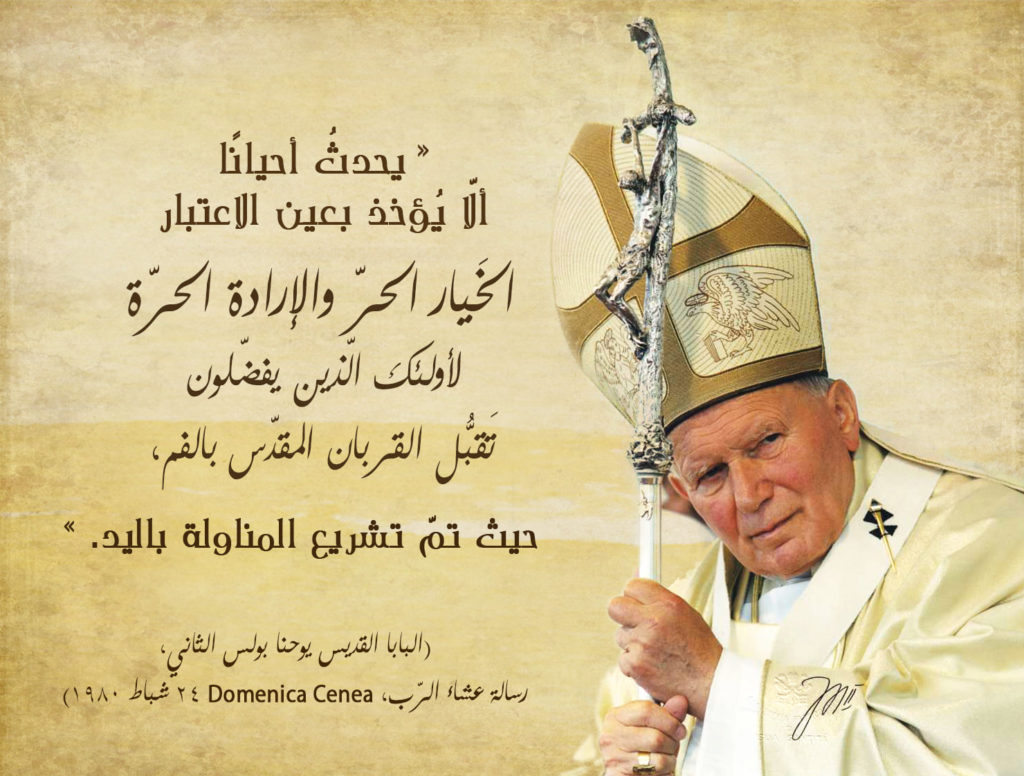*♰*
♰ مجمع العبادة الإلهيّة، 29 أيار 1969 ♰
الرّسالة البابويّة.. شّهر كانون الأول مخصّص لإكرام القربان الأقدس!

1- ضرورة المحافظة على طريقة إعطاء القربان التّقليديّة
“خلال احتفالها بـ”ذِكرى الرّبّ”، تشهدُ الكنيسة من خلال هذا الطّقس لإيمانها بالمسيح ولعبادتها له، المسيح الحاضر في الذّبيحة، والمُعطَى زادًا للمُشاركين في مائدته الافخارستيّة. لهذا السّبب، إنّه لضرورةٌ قُصوى أن يَتمّ الاحتفال بالقُربان المقدّس ويُعطى على نَحوٍ مُثمرٍ ولائقٍ، مِن خلال المحافظة على التّقليد من غير أيّ تغييرٍ؛ التّقليد الّذي وَصلنا إليه خُطوةً خُطوةً، والَّذي تَدفَّقَ غِناهُ في مُمارساتِ الكنيسة وحَياتِها.
2- المناولة تحت الشَّكليَن من جديد
تُظهرُ الوثائقُ التاريخيّة أنَّ طرق الاحتفال بالقربان المقدّس وتلقيّه كانت متنوّعة. حتّى في عصرنا هذا، تمّ إدخال العديد من التّغييرات الطّقسيّة الهامّة في الاحتفال الإفخارستيّ، كي تتوافق مع الاحتياجات الرّوحيّة والنفسيّة للبشر. وبسبب الظروف، أصبح التّناول، مرّةً أخرى، تحت كِلا الشَّكلين: الخبز والخمر، جِزءًا من الأنظمة الّتي تُحدّد طريقة المؤمنين في تناول القربان المقدّس، والذي كان شائعًا في الطّقس اللّاتينيّ، غير أنّه أُهمِل شيئًا فشيئًا.
وقد نَشأ وضعٌ مختلفٌ، أثناء انعقاد مجلس “ترانت”، وكان ساري المفعول في كلّ مكان؛ وقد صادق عليه ودافع عنه المجمع بما يُناسب ظروف تلك الفترة.
3- العودة إلى المناولة باليد من دون موافقة الكرسيّ الرّسوليّ!
مع هذا التجديد في طرق المناولة (الخبز والخمر)، تَحقَّقت علامةُ العشاء الإفخارستيّ كما تحقّق أيضًا اكتمالُ وصيّةِ المسيح بشكلٍ أكثر وضوحًا وحيويّة.
في الوقت نفسه، إنّ المشاركة الكاملة في الاحتفال بالإفخارستيا، والمُعبَّر عنها في تناول القربان، أثارت، مؤخّرًا، في بعض الأماكن، الرّغبة في العودة إلى ممارسة تناول المؤمنين بوضع القربان على أيديهم، ومن ثمّ التّناول بأنفسهم بفهم.
لقد تمّ اعتماد هذه الطريقة في بعض المجتمعات والأماكن من دون الحصول على مُوافقةٍ مُسبَقة من الكُرسيّ الرّسولي!! وأحيانًا أيضًا دون إعدادٍ مناسبٍ للمؤمنين حتّى. صحيحٌ أنّه وِفقًا للعادات القديمة، كان يسُمِحَ للمؤمنين بأخذ المناولة بأيديهم ليتناولونها بفمهم، وأنّه في الحَقبة المسيحيّة الأُولى سُمِحَ لهم بِحَمل القربان المقدّس من مكان الاحتفال. كان هذا في الأساس حتّى يتمكّنوا من إعطاء أنفسهم القربان للمرّة الأخيرة، في حال اضطُرّوا إلى مواجهةِ الموت من أجل إيمانهم. ومع ذلك، فإنّ تعاليم الكنيسة وكتابات الآباء تشهدُ بوفرةٍ على الوقار الكبير والانتباه اللَّذَين أُظهِرا نحو القربان المقدّس. لأنّه “لا أحد يأكل هذا الجسد، إلّا إذا عبَدهُ أولاً” (2) وتمّ تحذير كلّ مُتناولٍ: “…. تناوَلْهُ، واحرِصْ ألّا يضيعَ منهُ شيئًا” (3): “لأنّ هذا هو جسد المسيح “. (4)
في تلك الأثناء، أُوكِلت رعاية جسد الرّب ودمه وتوزيعهما، بطريقة خاصّة، إلى الكهنة المكرّسين، أو إلى الأشخاص المكرّسين خِصّيصًا لهذه الوظيفة (الخَدمة): “بعد أن يُكمِل المُحتفِل الصّلوات ويهتف المؤمنين، يُوزِّع مَن نُسمِّيهم “الشَّمامسة الخُدّام” الخُبز والخمر على الحاضرِين، ثمّ يُرفَعُ الشّكر من أجلهما، ويأخذونهما إلى الغائبين “. (5) ولكن سُرعان ما أُوكِلت إلى الكهنة المكرّسين فقط مَهَمَّة إرسال القربان المقدّس إلى الغائبين، لأنّ ذلكَ يُعطي اهتمامًا أعظم بالاحترام الواجب نحو جسد المسيح من جهةٍ، ولتلبية احتياجات النّاس من جهة أخرى.
لكن فيما بعد، ومع غوصٍ أعمق في السّرّ الإفخارستيّ ومفاعيله وحضور المسيح فيه، وُلدَ إحساسٌ أعظم بالاحترام نحو هذا السرّ المقدس، وفَهمٌ أكبر بأنّ قبولَه يتطَلَّبُ تواضُعًا أعمَق. وبهذا، تَغيّرت الطّريقة، وصار الكاهن هو من يضَعُ بنفسه قطعةَ الخُبزِ المُكَرَّس على لِسان المُتناوِلين.
4- المناولة بالفم فقط لأنّها تُبعد أيّ خطرٍ للتّدنيس!
بالنّسبة إلى حالة الكنيسة في العالم كُلِّه اليوم، يَجب تطبيق طريقة توزيع المناولة المقدّسة هذه (بالفم مباشرةً)، ليس فقط لأنّها تستند إلى تقليدٍ يمتدّ على مدى قرونٍ عديدة، ولكن، بخاصّةٍ، لأنّها علامة احترامٍ من قِبَلِ المؤمن للإفخارستيا. فهذه الممارسة لا تُنَقِّصُ، بأيّ طريقةٍ من الطّرق، من الكرامة الشخصيّة لأولئك الّذين يقتربون من هذا السّرّ العظيم، فهي جزءٌ من استعدادهم الواجِب عليهم لكي يكونَ تناولُ جسدِ الرّبِّ مُثمِرًا. (6) فإنَّ هذا التَّبجيل لدليلٌ على أنّنا لا نتناول “خبزًا وشرابًا عادِيَّين” (7) إنّما جسد الرّب ودمه، وبهذا التّبجيل “يشتركُ شعب الله في بركات ذبيحة الفصح، ويُجدّدون العهد الجديد الذي صنعه الله مع الإنسان بدم المسيح. وبالإيمان والرّجاء والمحبّة، يُجسّدون ويَستبقون الوليمة النُّهيويّة في مَلكوت الآب. ” (8)
زِد على ذلك، أنّ طريقة التّناول هذه، والّتي يجب اعتمادها الآن كما يُوصي التّقليد، تَضمَنُ توزيع المناولة المقدّسة بما يلزَم من الاحترام واللّياقة والكَرامة؛ كما أنّها تُبعِدُ أيّ خطرٍ في تدنيس أَجزاء القربان؛ حيثُ “المسيح كلّه وبكامله، الإله والإنسان، هو موجودٌ بشكلٍ جوهريٍّ، وبشكلٍ دائمٍ، وبطريقةٍ فريدةٍ.” (9) وأخيرًا، تضمنُ هذه الطّريقة الاحتراس الدَّقيق والدَّؤوب، الَّذي طالما أوصَتْ به الكنيسة، على أصغر فُتاتٍ من الخبز المُكرّس: “إن عَرَّضتَ أيَّ جزءٍ للضَّياع، فكِّر كأنّكَ تخسَرُ أحدَ أعضاءِ جَسدِكَ الخاصّة.” (10)
5- أخطار تدنيس القربان في المناولة باليد
بناءً على ما تقدّم، وبعد طلب بضعة لجان أسقفيّة وبعض الأساقفة السّماح بالمناولة باليد في مناطقهم الخاصّة، قرّر الكرسيّ الرّسولي أنّه يجب على كلّ أسقفٍ في الكنيسة اللّاتينيّة أن يُسألَ عن رأيه حول مَدى مُلائمة إدخال هذه الممارسة. فالتّغييرُ في مسألةٍ بهذا المقدار مِن الأهميّة عائدةً إلى تقليدٍ قديمٍ ومُقدَّسٍ للغاية من جهة، والمَساسُ بالقوانين من جهةٍ أُخرى، يُشكِّلان أخطارًا مُعيّنةً قد تَنشأ من هذه الطّريقة الجديدة في إعطاء المناولة المقدّسة، وهي: خطر فُقدان الحسّ بالوَقار المَهيب لِسرّ المذبح (القربان)، خطر التّدنيس، وانتهاك العقيدة الصَّحيحة. (الإيمان بحقيقة حضور المسيح في القربان)
لذلك تمّ طرح ثلاثة أسئلة على الأساقفة، وقد جاءت الأجوبة، حتّى 12 آذار، كالتّالي:
1- هل ينبغي قبول الاقتراح بالسّماح بالمناولة باليد، إلى جانب الأسلوب التّقليديّ (بالفم)؟
نعم: 567 / لا: 1,233 / نعم (ولكن مع شروط): 315
2- هل ينبغي تجربة هذه الممارسة الجديدة في مجتمعاتٍ صغيرةٍ، بموافقة الكاهن المحلّي؟
نعم: 751 / لا: 1,215 / أصوات حياديّة: 70
3- هل تظنّ بأنّ المؤمن سيَقبلُ بهذه الممارسة الجديدة بإرادته، بعد تحضيرٍ تعليميٍّ مُبرمجٍ بطريقةٍ جيّدة؟
نعم: 835 / لا: 1,185 / أصوات حياديّة: 128
6- لا يجب تغيير المناولة بالفم أبدًا
من الإجابات الّتي تلقّيناها، يبدو لنا واضحًا بأنّ العدد الأكبر من الأساقفة يرونَ بأنّه لا يجب تغيير الأنظِمة الحاليّة أبدًا (المناولة بالفم). وفي حال تمّ تغييرها، سيُشكّلُ هذا الأمر إهانةً حقيقيّةً للقيمة الرّوحيّة لهؤلاء الأساقفة ولمعظم المؤمنين، ومشاعرهم.
لذلك، إنّ الأخذ بالاعتبار ملاحظات مَن “أَقَامَهُمُ الرُّوحُ الْقُدُسُ أَسَاقِفَةً، ليَرْعَوْا” الكنائس (أع 20: 21)، وبالنّظر إلى جَدِّيّةِ هذه المسألة، وقوّة الحجج المطروحة، قرَّر الأب الأقدس عدم تغيير أسلوب توزيع المناولة المقدّسة للمؤمن، والمُعتَمد منذ عهدٍ بعيدٍ. (من الكاهن وبالفم)
لذلك، فإنّ الكُرسيّ الرّسوليّ يحثُّ، بقوّةٍ، الأساقفة والكهنة والعِلمانيّين على طاعة هذا القانون، بكلّ غيرة – القانون الّذي لا يزال ساريًا، والّذي نؤكّده مجدّدًا. كما يحثُّهم الكرسيّ الرّسوليّ على مُراعاة حُكم غالبيّة الأساقفة الكاثوليك، بالطريقة المستخدَمة حاليًّا في اللّيتورجيا، وذلك لخير الكنيسة العام.
ولكن إذا كانت الممارسة المُعاكسة، أي التّناول باليد، قد سبقت وانتشرت في مكانٍ ما، فالكرسيّ الرّسولي من أجل مساعدة المجالس الأُسقفيّة في إتمام مهامها الرّاعويّة – الصّعبة في أغلب الأحيان اليوم- يُلقي على عاتق هذه المجالس مَسؤوليّةَ قياس أيّة ظروفٍ خاصّةٍ قد تَطرأ هناك، بكلّ عناية. كما يُلقي عليها أيضًا مسؤوليّة الانتباه لتجنّب أيّ خطرٍ لقلّة الاحترام أو المعتقدات الخاطئة تجاه القربان المقدّس، كما وتجنّب أيّ نتائج سَلبيّةٍ أُخرى قد تنتُج.
7- لا تسري المناولة باليد دون موافقة روما وإذنها
وفي مثل هذه الحالات، يجب أن تدرُس المجالس الأُسقفيّة الأمور بعنايةٍ كبيرةٍ، ويجب أن تتّخذ أيّ قراراتٍ مطلوبة لتنظيم الأمور، من خلال التّصويت السِّريّ، وبأغلبيّة الثّلثيَن. يجب أن ترسل قراراتها إلى روما، مَصحوبةً بسردٍ تفصيليٍّ للأسباب التي دفعت الأساقفة إلى اتّخاذ تلك القرارات، وذلك من أجل الحصول على الموافقة اللّازمة. [12] والكُرسيّ الرسوليّ بدوره سيدرُس كلّ حالةٍ بعنايةٍ، مع مُراعاة الرَّوابط بين الكنائس المحليّة المُختلفة من جهة، وبين كلٍّ منها والكنيسة الجامعة من جهةٍ أخرى، ذلك بهدف تعزيز الخير العام وبُنيان الجميع، وكي يَزيد المَثل الصَّالح المشترك مِن الإيمانِ والتّقوى.
البابا بولس السّادس
المراجع:
- Cf. Council of Trent, session 21, The Doctrine of Communion under Both Kinds: Denz. 1726-1727.
- St. Augustine, On the Psalms, 98, 9.
- St. Cyril of Jerusalem, Mystagogic Catechesis, V, 21.
- Hippolytus, Apostolic Tradition, n. 37.
- Justin, Apologia, 1, 65.
- See St. Augustine, On the Psalms98, 9.
- See Justin, Apologia1 66.
- Instruction Eucharisticum Mysteriumn. 3.
- Ibid., n. 9.
- St. Cyril of Jerusalem, Mystagogic CatechesisV; 21.
- See Acts 20:28.
- See Vatican II Decree Christus Dominus, n. 38, par. 4.
المصدر: Instruction on the Manner of Distributing Holy Communion | EWTN
(ترجمة غير رسميّة – صفحة @قلب مريم المتألم الطاهر)
MEMORIALE DOMINI
Instruction on the Manner of Distributing Holy Communion
Sacred Congregation for Divine Worship
Issued on May 29, 1969.
When the Church celebrates the memorial of the Lord it affirms by the very rite itself its faith in Christ and its adoration of him, Christ present in the sacrifice and given as food to those who share the eucharistic table.
For this reason it is a matter of great concern to the Church that the Eucharist be celebrated and shared with the greatest dignity and fruitfulness. It preserves intact the already developed tradition which has come down to us, its riches having passed into the usage and the life of the Church The pages of history show that the celebration and the receptions of the Eucharist have taken various forms. In our own day the rites for the celebration of the Eucharist have been changed in many and important ways, bringing them more into line with modern man’s spiritual and psychological needs. Further, a change has taken place in the discipline governing the laity’s participation in the sacrament. Holy communion under two kinds, bread and wine has been reintroduced. It had once been common in the Latin Church too, but had subsequently been progressively abandoned. This state of affairs had become general by the time of the Council of Trent, which sanctioned and defended it by dogmatic teaching as being suited to the conditions of that time.[1]
These changes have made of the eucharistic banquet and the faithful fulfillment of Christ’s command a clearer and more vital symbol. At the same time in recent years a fuller sharing in the eucharistic celebration through sacramental communion has here and there evoked the desire to return to the ancient usage of depositing the eucharistic bread in the hand of the communicant, he himself then communicating, placing it in his mouth.
Indeed, in certain communities and in certain places this practice has been introduced without prior approval having been requested of the Holy See, and, at times, without any attempt to prepare the faithful adequately.
It is certainly true that ancient usage once allowed the faithful to take this divine food in their hands and to place it in their mouths themselves.
It is also true that in very ancient times they were allowed to take the Blessed Sacrament with them from the place where the holy sacrifice was celebrated. This was principally so as to be able to give themselves Viaticum in case they had to face death for their faith.
However, the Church’s prescriptions and the evidence of the Fathers make it abundantly clear that the greatest reverence was shown the Blessed Sacrament, and that people acted with the greatest prudence. Thus, “let nobody . . . eat that flesh without first adoring it”[2] As a person takes (the Blessed Sacrament) he is warned: ” . . . receive it: be careful lest you lose any of it.”[3] “For it is the Body of Christ.”[4]
Further, the care and the ministry of the Body and Blood of Christ was specially committed to sacred ministers or to men specially designated for this purpose: “When the president has recited the prayers and all the people have uttered an acclamation, those whom we call deacons distribute to all those present the bread and wine for which thanks have been given, and they take them to those who are absent.”[5]
Soon the task of taking the Blessed Eucharist to those absent was confided to the sacred ministers alone, so as the better to ensure the respect due to the sacrament and to meet the needs of the faithful. Later, with a deepening understanding of the truth of the eucharistic mystery, of its power and of the presence of Christ in it, there came a greater feeling of reverence towards this sacrament and a deeper humility was felt to be demanded when receiving it. Thus the custom was established of the minister placing a particle of consecrated bread on the tongue of the communicant.
This method of distributing holy communion must be retained, taking the present situation of the Church in the entire world into account, not merely because it has many centuries of-tradition behind it, but especially because it expresses the faithful’s reverence for the Eucharist. The custom does not detract in any way from the personal dignity of those who approach this great sacrament: it is part of that preparation that is needed for the most fruitful reception of the Body of the Lord.[6]
This reverence shows that it is not a sharing in “ordinary bread and wine”[7] that is involved, but in the Body and Blood of the Lord, through which “The people of God share the benefits of the Paschal Sacrifice, renew the New Covenant which God has made with man once for all through the Blood of Christ, and in faith and hope foreshadow and anticipate the eschatological banquet in the kingdom of the Father.”[8]
Further, the practice which must be considered traditional ensures, more effectively, that holy communion is distributed with the proper respect, decorum and dignity. It removes the danger of profanation of the sacred species, in which “in a unique way, Christ, God and man, is present whole and entire, substantially and continually.”[9] Lastly, it ensures that diligent carefulness about the fragments of consecrated bread which the Church has always recommended: “What you have allowed to drop, think of it as though you had lost one of your own members.”[10]
When therefore a small number of episcopal conferences and some individual bishops asked that the practice of placing the consecrated hosts in the people’s hands be permitted in their territories, the Holy Father decided that all the bishops of the Latin Church should be asked if they thought it opportune to introduce this rite. A change in a matter of such moment, based on a most ancient and venerable tradition, does not merely affect discipline. It carries certain dangers with it which may arise from the new manner of administering holy communion: the danger of a loss of reverence for the august sacrament of the altar, of profanation, of adulterating the true doctrine.
Three questions were asked of the bishops, and the replies received by 12 March 1969 were as follows:
1. Do you think that attention should be paid to the desire that, over and above the traditional manner, the rite of receiving holy communion on the hand should be admitted?
Yes: 597
No: 1,233
Yes, but with reservations: 315
Invalid votes: 20
2. Is it your wish that this new rite be first tried in small communities, with the consent of the bishop?
Yes: 751
No: 1,215
Invalid votes, 70
3. Do you think that the faithful will receive this new rite gladly, after a proper catechetical preparation?
Yes: 835
No: 1,185
Invalid votes: 128
From the returns it is clear that the vast majority of bishops believe that the present discipline should not be changed, and that if it were, the change would be offensive to the sentiments and the spiritual culture of these bishops and of many of the faithful.
Therefore, taking into account the remarks and the advice of those whom “the Holy Spirit has placed to rule over” the Churches,[11] in view of the gravity of the matter and the force of the arguments put forward, the Holy Father has decided not to change the existing way of administering holy communion to the faithful.
The Apostolic See therefore emphatically urges bishops, priests and laity to obey carefully the law which is still valid and which has again been confirmed. It urges them to take account of the judgment given by the majority of Catholic bishops, of the rite now in use in the liturgy, of the common good of the Church.
Where a contrary usage, that of placing holy communion on the hand, prevails, the Holy See—wishing to help them fulfill their task, often difficult as it is nowadays—lays on those conferences the task of weighing carefully whatever special circumstances may exist there, taking care to avoid any risk of lack of respect or of false opinions with regard to the Blessed Eucharist, and to avoid any other ill effects that may follow.
In such cases, episcopal conferences should examine matters carefully and should make whatever decisions, by a secret vote and with a two-thirds majority, are needed to regulate matters. Their decisions should be sent to Rome to receive the necessary confirmation,[12] accompanied with a detailed account of the reasons which led them to take those decisions. The Holy See will examine each case carefully, taking into account the links between the different local churches and between each of them and the Universal Church, in order to promote the common good and the edification of all, and that mutual good example may increase faith and piety.
———————————–
Note: in the Acta Apostolicae Sedis (pp. 546-547) the Instruction was accompanied by a sample of the letter (in French) which is sent to hierarchies who ask for and are granted permission to introduce the practice of holy communion on the hand. The letter laid down the following regulations:
1. The new method of administering communion should not be imposed in a way that would exclude the traditional usage….
2. The rite of communion in the hand must be introduced tactfully. In effect, since human attitudes are in question, it is linked with the sensibility of the person receiving communion. It should therefore be introduced gradually, beginning with better-educated and better-prepared groups. It is, above all, necessary that an adequate catechesis prepares the way so that the faithful will understand the significance of the action and will perform it with the respect due to the sacrament. The result of this catechesis should be to remove any suggestion of wavering on the part of the Church in its faith in the eucharistic presence, and also to remove any danger or even suggestion of profanation.
3. The fact that the lay person is now able to receive holy communion in the hand should not suggest to him that this is ordinary bread, or just any sacred object. Rather ought it to strengthen his sense of his dignity as a member of the Mystical Body of Christ, of which baptism and the grace of the Eucharist make him a part. He will thus experience an increase of faith in the great reality of the Body and Blood of the Lord which he touches with his hands. His respectful attitude should be proportionate to what he is doing.
4. With regard to the manner of administering the sacrament, one may follow the traditional method, which emphasized the ministerial function of the priest or deacon, in having them place the host in the hand of the communicant. One may also adopt a simpler method, allowing the communicant himself to take the host from the ciborium. In either case, the communicant ought to consume the host before returning to his place, and the minister’s role will be emphasized by his saying, “The Body of Christ,” to which the communicant responds, “Amen.”
5. No matter which method is adopted, one will be careful not to allow any fragment of the host to fall….
6. When the communion is distributed under both kinds, it is never permitted to place in the hands of the communicants hosts which have first been placed in the Blood of the Lord.
7. Bishops who have been permitted to introduce the new rite of communion are asked to send a report to the congregation, six months hence, on the outcome.
[Translated by Rev. Austin Flannery, O.P. from AAS 61 (1969), pp. 541-547.]
Endnotes
1. Cf. Council of Trent, session 21, The Doctrine of Communion under Both Kinds: Denz. 1726-1727.
2. St. Augustine, On the Psalms, 98, 9.
3. St. Cyril of Jerusalem, Mystagogic Catechesis, V, 21.
4. Hippolytus, Apostolic Tradition, n. 37.
5. Justin, Apologia, 1, 65.
6. See St. Augustine, On the Psalms 98, 9.
7. See Justin, Apologia 1 66.
8. Instruction Eucharisticum Mysterium n. 3.
9. Ibid., n. 9.
10. St. Cyril of Jerusalem, Mystagogic Catechesis V; 21.
11. See Acts 20:28.
12. See Vatican II Decree Christus Dominus, n. 38, par. 4.
 Agoraleaks Agoraleaks
Agoraleaks Agoraleaks







